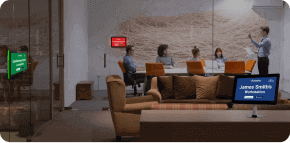Blog

agility in the workplace Five Ways To Boost Work Environment
The corporate world is developing rapidly thanks to widespread cultural and technical development. As a result, corporations and private businesses must continuously adapt and innovate to stay current with changing market conditions. Boosting room capacity availability is done by welcoming workplace adaptability.
agility in the workplace is the capacity to operate quickly, smoothly, and cohesively to provide higher levels of production and engagement. In addition, agility allows workplaces to adapt and blend in smoothly with changes and developments that occur over time in the marketplace.
Room Capacity: What Defines It And Its Importance In The Modern Office
Room capacity is the number of people who can use the space safely. Space utilization helps office administration to assign equal weight to how many people can comfortably fit in a room.
The workplace occupancy rate is a crucial indicator to monitor. The rate aids businesses in determining how many resources they will require. The occupancy rate is an essential indicator of whether office spaces get overcrowded or underutilized.
Team member productivity can suffer in an overly crowded workplace, which impairs their experience. On the other hand, underutilizing an office costs organizations money. However, the occupancy rate is only one aspect of the puzzle. Agility in the workplace promotes more significant space usage.
Workplace Agility: What Is It?
The ability to think swiftly is what agility means. The significance of the term “agility in the workplace” now becomes much more apparent when applied to the workplace.
Workplace agility is the capacity to operate quickly, smoothly, and cohesively to provide higher levels of production and engagement. agility in the workplace allows workplaces to adapt and blend in smoothly with changes and developments that occur over time in the marketplace.
The Five Advantages Of An Agile Workplace
The advantages of having an adaptable staff provide for the improvement and expansion of the company. In addition, proper planning boosts the workplace environment with an agile workplace. The following are five advantages of increasing agility in the workplace:
1 Decreased Office Costs And Turnover
Working-from-home policies have become standard for the past few years. As a result, business firms are now much more flexible with varying working hours.
An office without cramped workspaces allows administrators for proper facilities planning. Admins team members come into the office to work for the day or the week, reducing the costs spent on facility resources. An adaptable workspace will attract more talent and retain staff, decreasing turnover rates.
agility in the workplace allows workers to save up on travel expenses and office space. In addition, the flexibility of the working environment has a favorable effect on both workers and the organization’s yearly budget.
2 Flexibility
The traditional method of office work usually meant showing up at nine to five. Team members typically need to attend the office to complete work tasks.
A significantly more flexible work schedule for the employees is made possible by an agile workplace. Team members can choose their work hours, especially in more productive time slots. In the end, this leads to more energy and productivity.
3 Boost Workplace Variety
Emphasizing diversity hiring not only enriches the workplace culture but also brings in a variety of perspectives that enhance creativity and innovation. Whether temporary or permanent, team members are eligible in a flexible work environment. Additionally, agile workplaces believe in breaking the mold of traditional office work by giving opportunities.
Additionally, it creates many opportunities to understand each person’s preferences and requirements. Agile workplaces foster skill diversity and culture, which focuses on the needs of team members.
4 Better Health And Employee Satisfaction
Agility in the workplace allows team members to regulate their hours, finish projects, and collaborate. It offers the ideal setting for employees to submit innovations and ideas that improve productivity.
Employees accomplish their tasks within the time since they can work without interruption. Also, team members can take breaks and catch their breath with a flexible schedule, which helps them maintain their health.
5 Everyone Benefits From An Agile Workplace
Agile workplaces benefit everyone who works there, not just the team members. Management and administrators must benefit from a flexible working environment. Firms must break the traditional mold to remain competitive and empower staff to promote higher engagement.
An entire firm works together in an agile workplace, achieving its long-term goals and objectives faster. A flexible working environment eliminates the office ranking aspect. Mutual respect and trust exist. Additionally, since everyone is familiar with their processes, there is no opportunity for micromanagement and no potential for workplace toxicity.
Calculating Room Capacity: Four Metrics To Help Measure Workplace Occupancy And Boost Flexibility
The five advantages of two agility in the workplace undoubtedly benefit any business in the long run. However, how do administrators and managers achieve efficient room capacity for better flexibility?
Here are four metrics to help measure workplace occupancy and help enhance flexibility:
Usage Of Space
A crowded office is a successful workplace. But, although that might be the case, between bustling and packed, there is a distinction. Therefore, it’s critical to determine space usage to enable precise facilities planning.
When examining space use, it’s vital to consider the following elements into account:
- How many hours are set out for meetings each day?
- Number of users in a particular location at a specific moment.
- Total space capacity
- The maximum number of attendees per meeting room
- Areas where team members and staff move about the most
Monitoring space use will improve workplace occupancy awareness and assist in staffing and resource planning.
Visitor Traffic
Visitor traffic is a vital workplace measure to monitor. Building administrators must understand how many visitors come onsite weekly or monthly. The traffic data ensures that the building can withstand the increased visitor traffic. Furthermore, facility administrators must ensure they can accommodate visitors requiring a workstation, conference room, etc.
Next, it’s crucial to examine visitor traffic data for trends. For example:
- Are there more visitors on particular days?
- Is it common for HR to schedule candidate interviews on Wednesdays or Thursdays?
- Are board meetings always held on the same day of the month?
Knowing and understanding the metrics of visitor traffic assists in efficient resource allocation.
Desk And Employee Ratio
Flexible scheduling and agility in the workplace in the workplace still require desks and spaces. It would rely on the office’s workplace policy. It would rely on the office’s workplace policy. A hybrid workforce makes the ratio challenging due to hot desking. It would rely on the office’s workplace policy.
Proper tools such as desk booking software assist in desk tracking. Office admins should examine the number of employees signing in for the day and the number of booked desks. Proper tools such as desk booking software assist in desk tracking. For offices that do not have mechanisms in place, they can manually track desk utilization for two weeks.
Utilization Of Meeting Rooms
Another essential indicator to track for space management is meeting room usage. Nobody enjoys sitting in a small conference room with far too many people. While being the only person in a meeting room when ten others are on a video call is not a pleasant experience.
Meeting room utilization, unlike desk utilization, is less prominent. It’s vital to consider the following:
- The most commonly booked meeting rooms
- The number of people physically present
- The type of meeting (planned or impromptu)
Examining these many measures can assist firms in painting a thorough picture of space utilization across all their workplaces. Business owners and administrators find better information and create data-driven decisions on optimizing spaces. It also provides the best flexible working experience for team members onsite.
Agility In Today’s Workplaces
Digital transformation efforts made agility in the workplace vital for all business divisions. An agile workforce requires a nimble workplace as well. Allocating resources quickly work towards an efficient office space for different types of team members to work on.
Business agility is only possible when employees can respond quickly to solve problems—using an effective decision-making process and team member empowerment to benefit the cause greatly. When staff must complete, it speeds up the process of appraising a problem and increases efficiency.
Adopting an agile workplace necessitates a careful balance of people, digital transformation, and business objectives. Changing procedures, technology, department structures, and culture are vital for workplace agility. A room capacity may differ, but business owners can create an efficient work area with the appropriate resources.
Conclusion
The ability of an organization to become agile is a process that takes time to develop. It requires everyone’s ongoing support. Otherwise, the system will fail in the long run. Business leaders must also emphasize continuous improvement and provide staff with opportunities.
A thorough understanding of space utility will assist firms in making the most of their premises. It also boosts facility management capabilities. An agile workforce can have the opportunity and willingness to adapt to changes. As a result, businesses may make more cost-effective decisions that do not jeopardize operations or team member safety.
The tools today have made life considerably more accessible and streamlined activities. Understanding facilities planning gives any company a competitive edge. It is critical to implement the practice of collaboration in a company since it provides opportunities for team building. There is a smooth exchange of knowledge and expertise among teams and employees, thus, significantly improving cross-functionality.















































 Support
Support  Demo
Demo  Blog
Blog